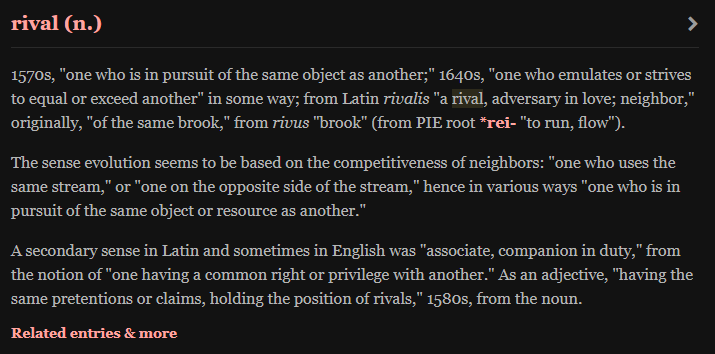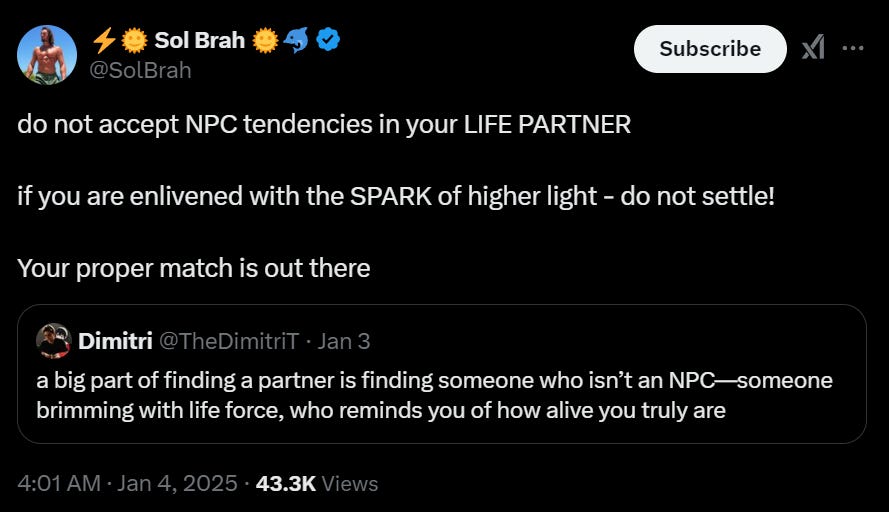A brief thought I had while styling my hair.
I have listened to The Value of Others by Orion Taraban. I think that this is a book that methodically and thoroughly discusses the topic it reports itself to be about. I appreciate his analysis and regard it as quite accurate. However, I would like to suggest that it is also fairly incomplete.
It compares the behavior within traditional heterosexual relationships of the previous generation to that of today. This behavior has changed quite significantly. He, I think rightly, identifies the profusion of birth control and pornography as explanations for people's shifting behaviors within the arena of value exchange in relationships.
I think he is really quite right to say that relationships are the medium in which value is exchanged. And we must remember that there are inextricable links between a medium and its message. However, I believe this is only one province in the country of relationship, and if we would like to understand our issues better, we need to capture it in whole.
I would like to draw a metaphor with a few other polarizing subjects. Firstly, language—it is a medium of communicating information, but it is also a cognitive tool or lens.1 Secondly, sharing—sharing can be a fraught site of rivalry where desire is stoked mimetically, but it can also be an expanding site of joint attention where desires are unveiled. Much like value, desire is a current, constituted through more or less abundant arrangements of attentional exchange, and it thus requires the medium of relationships in which to grow. These two things are not the same, though; they are each other's mirror image: value is a positive phenomenon, applied to goods that are present, and desire is a negative phenomenon, aroused by that which is lacking.
Although I was compelled by his idea of the innate asymmetry of desire, I believe Orion mistakenly folds the issue of our desire for others into the issue of our exchange of value with them. He does not ask where desire comes from; he just assumes it is there and thus ignores an entire province of relationship in the process. He does, however, distinguish love from relationship, and I think he properly defines it as its own country. To follow the metaphor: sure, you may have expats from love living within the borders of a relationship, but the two need to negotiate against each other at the UN. Likewise, love is not desire.
I would like to address here the struggle that any rigorous analysis runs into: the shifting polysemy of words. Words do not mean one thing. I have tried to make a neat structure of concepts above. But as a person with a body and soul who has navigated relationships, the way that I would describe the missing factor in The Value of Others is with the word "companionship." So let me try to slot this synthesized feeling into the abstract structure above.
I think its place is most readily observable when we consider something I discussed with Daniel Garner of O.G. Rose and Javier Rivera late last year: the difference between mimetic desire and joint attention. Like The Value of Others, mimetics represents a logic that governs a substantial domain of our motivations toward objects.2
People are lonely. They want companionship. This is not satisfied by competitors in a market nor by objects of pursuit. A companion holds joint attention; it persists with you.
This is all occurring within an environment where subjectivity has changed in the last several generations, and so has the topography of attention. It is not just pornography or social media (sometimes the same thing) affecting the exchange of value across relationships. Instead, you have subjectivities that are increasingly alienated, wherein the attention of these subjects is increasingly diverted away from each other in a vast rhizomatic3 spreading structure and more into centralized radial nodes. Where I would have given a large portion of my minutes of attention to those I am in relation to, the para-social realm diverts that toward those and that which I am not in relation with. It is not just that the exchange of value through relationship markets is being expanded. It is also that attention, as the goods of desire, is being offshored from the country of relationships entirely.
We attend to each other less and less, and we attend with each other less and less. We do so in a climate that already exacerbates existential loneliness. We need joint attention, and if we cannot perform it, we will suffice with the games of mimetic rivalry. Contrary to Orion's thesis, this makes committed relationships about more than only making children. And so you can see where the new modern demands for marrying your best friend come from.
It is difficult for a stranger or even a friend to remind you that you are Alive. Not just biologically alive, seeking resources and reproductive opportunity, but Alive: meta-biologically4 synthesizing the knower and the known in pursuit of meaning, even at the expense of reproductive opportunity. Perhaps Maslow is right, maybe some needs must come in greater measures than others, however it often feels like his pyramid is more of a circus tent, and that it is actually that small peak which pulls up the entire structure below.
Pico della Mirandola5 defines humans as being halfway between animals and angels. Our creative likeness to God is constituted by our freedom to become as one or the other. And so it seems natural that human life should always have these doubled parallel devices: language that is constitutive of our subjectivity and language that communicates our subjectivity, expansive joint attention, and rivalrous mimetic desire, singular companionships, and the comparable value of others.
The differences between these two provinces of language are rigorously analyzed at length by Charles Taylor in his two books The Language Animal, and Cosmic Connection.
See Rene Girard.
See the Rhizome chapter: Deluze, Guatari, A Thousand Plateaus.
Charles Taylor, The Language Animal.
See On the Dignity of Man.









